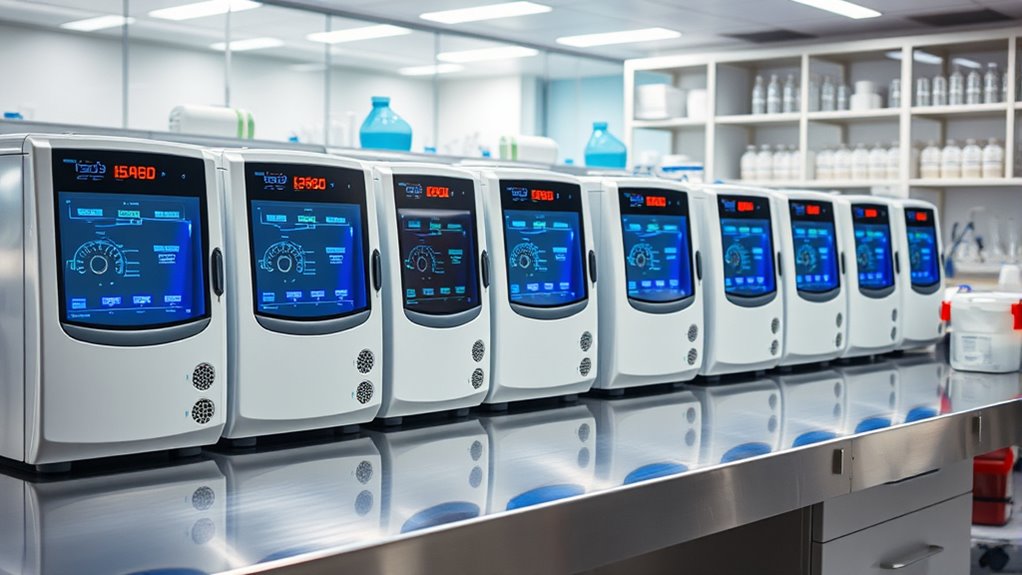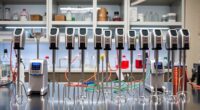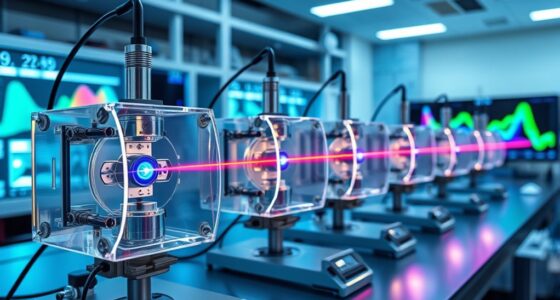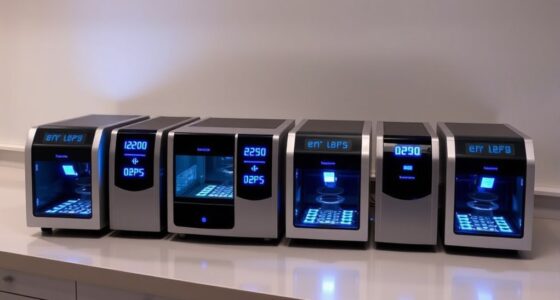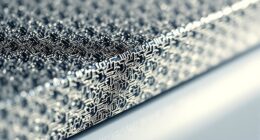If you’re looking for the 7 best high-speed ultracentrifuges of 2025, I recommend models that offer precise control, high RCF, and user-friendly features. The VEVOR centrifuge provides versatile speed regulation, while Corning’s models deliver high RPMs with digital displays, perfect for sensitive applications. Compact options like the Mxmoonant mini centrifuge offer speed and convenience. Combining advanced safety and efficiency, these options fit a range of laboratory needs. Keep exploring to discover detailed insights about each choice.
Key Takeaways
- Top models like VEVOR and Corning offer speeds above 13,000 rpm with high RCF for precise separation tasks.
- Advanced digital controls and programmable settings ensure accurate, customizable operation for diverse scientific applications.
- Built-in safety features such as imbalance alarms, auto lid-stop, and overheat protection enhance operational reliability.
- Compatibility with various rotor sizes and tubes (15 ml, microcentrifuge tubes) maximizes versatility and sample capacity.
- Low noise levels (<55dB) and vibration dampening contribute to efficient, stable, and quiet laboratory performance.
VEVOR Centrifuge Machine with 1 Rotor for Laboratory Use

If you’re looking for a reliable laboratory centrifuge that offers precise control and versatile sample handling, the VEVOR Centrifuge Machine with one rotor is an excellent choice. It provides accurate speed regulation from 500 to 4000 rpm and RCF up to 2100xg, with incremental adjustments for precision. The adjustable timer allows flexible operation, ensuring reliable results. Its rotor fits six 15/50ml tubes or blood collection tubes, accommodating various sample types. Safety features like auto lid-stop, overheat protection, and vibration dampening ensure stable, secure operation. Plus, the user-friendly control panel makes setup quick and straightforward, enhancing overall laboratory efficiency.
Best For: researchers and laboratory professionals seeking precise, versatile centrifugation for biological, medical, chemistry, or environmental science applications.
Pros:
- Precise speed control from 500 to 4000 rpm and adjustable RCF up to 2100xg for accurate sample separation
- Compatible with multiple sample sizes, including 15/50ml tubes and blood collection tubes, offering versatility
- Safety features such as auto lid-stop, overheat protection, vibration dampening, and a quiet operation under 55dB
Cons:
- Limited to a single rotor capacity, which may require additional units for high-volume labs
- The timer range (30 seconds to nearly 1 hour) may not suit very long or specialized centrifugation processes
- The compact design might restrict use with larger or specialized rotors or tubes
EISCO Polypropylene Conical Centrifuge Tubes, 15 ml (Pack of 50)
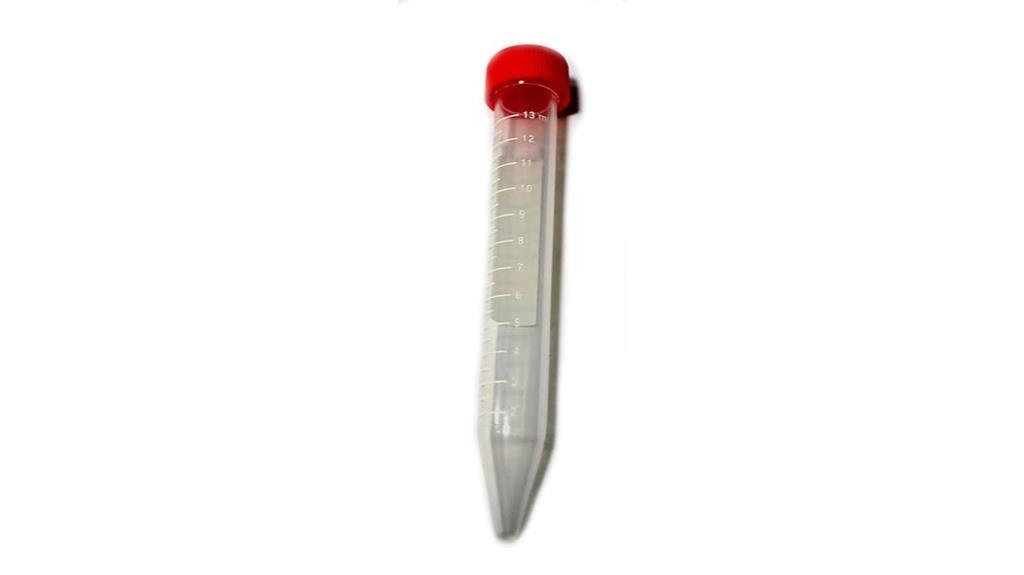
For labs seeking reliable and versatile centrifuge tubes, the EISCO Polypropylene Conical Centrifuge Tubes, 15 ml pack of 50, stand out as an excellent choice. Made from durable polypropylene, these tubes are suitable for a variety of laboratory applications. They feature clear 1 ml graduations for accurate measurement and sample handling. The high-density, flat screw caps ensure secure sealing and prevent leaks during high-speed spins. With a large, non-erasable marking area, labeling is easy and permanent. These tubes combine durability, ease of use, and precise measurements, making them ideal for scientific workflows that demand reliability and efficiency.
Best For: laboratories and scientific professionals seeking durable, precise, and secure centrifuge tubes for various sample handling applications.
Pros:
- Made from durable polypropylene for long-lasting use
- Clear 1 ml graduations enable accurate measurement
- High-density screw caps provide secure, leak-proof sealing
Cons:
- May be more expensive than basic plastic tubes
- Not suitable for high-temperature applications beyond polypropylene’s tolerance
- Large labeling area could be cumbersome for small samples
EISCO 5ml Borosilicate Glass Centrifuge Tube
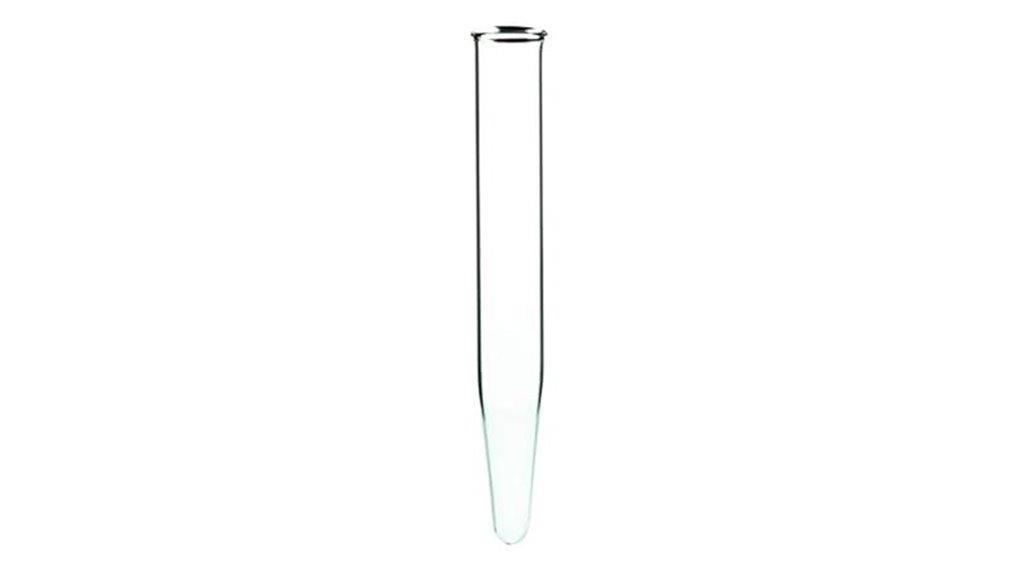
The EISCO 5ml Borosilicate Glass Centrifuge Tube stands out as an excellent choice for laboratory professionals seeking durability and reliability in their centrifugation procedures. Made from high-quality Borosilicate 3.3 glass, it offers superior chemical resistance and thermal stability, tolerating high temperatures and thermal shocks. Its conical shape and ungraduated design simplify sample handling and separation, while the absence of a cap allows quick access. With dimensions of 3.9 inches in height and 11mm inner diameter, this tube is suitable for various lab applications. Built to rigorous standards, it’s autoclavable and durable, ensuring consistent performance in demanding ultracentrifuge environments.
Best For: laboratory professionals and researchers requiring durable, high-temperature resistant centrifuge tubes for sample separation and processing.
Pros:
- Made from high-quality Borosilicate 3.3 glass for excellent chemical and thermal resistance
- Conical shape facilitates efficient sample separation and transfer
- Autoclavable and durable for repeated sterilization and use
Cons:
- No cap included, which may require additional purchase for certain applications
- Ungraduated design might limit precise volume measurement
- Dimensions may be too small for larger sample volumes
Corning LSE 6767-HS High Speed Digital Microcentrifuge with UK Plug, 230V
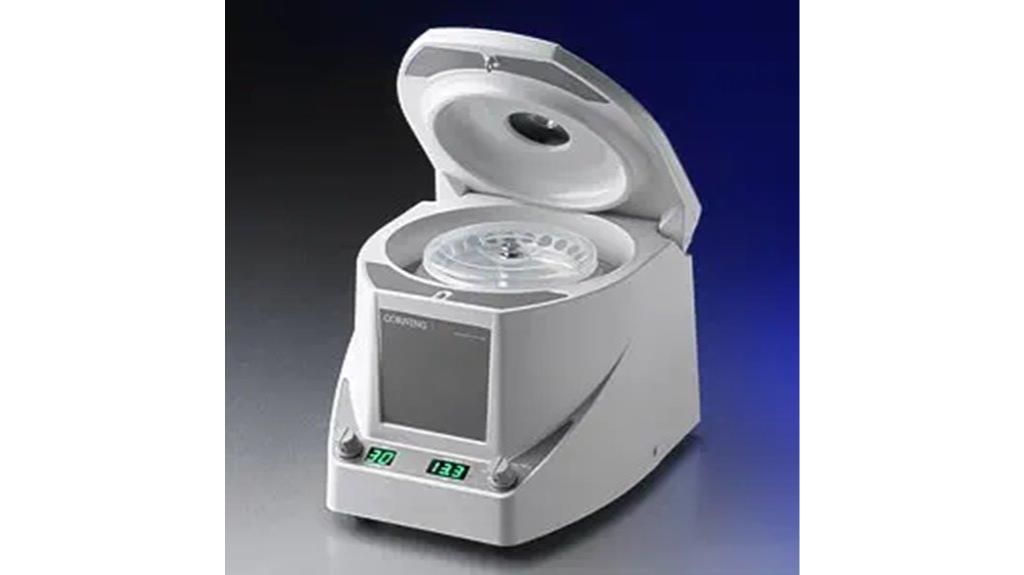
Designed for precision and ease of use, the Corning LSE 6767-HS High Speed Digital Microcentrifuge is ideal for laboratories needing rapid, reliable sample separation. It accelerates quickly to 13,300 rpm or 16,300 x g, ensuring efficient processing. Despite its power, it operates quietly and stays cool, even at maximum speed. The centrifuge features an easy-access rotor that holds 24 tubes of 1.5 or 2.0 mL. Its digital control system allows precise adjustments and displays rotor speed in rpm or g-force, giving me confidence in consistent, accurate results every time.
Best For: laboratories requiring rapid, high-speed sample separation with precise digital control and easy-to-use rotor access.
Pros:
- Accelerates quickly to 13,300 rpm / 16,300 x g for efficient sample processing
- Quiet and cool operation even at maximum speed, reducing noise and heat concerns
- Digital control with rpm and g-force display ensures accurate and consistent results
Cons:
- Limited to 24 tubes of 1.5/2.0 mL capacity, which may not suit larger sample volumes
- UK plug configuration may require adapters for use outside the UK
- No mention of additional features such as programmable settings or automated protocols
Corning LSE 6766-HS High Speed Digital Microcentrifuge with EU Plug, 230V
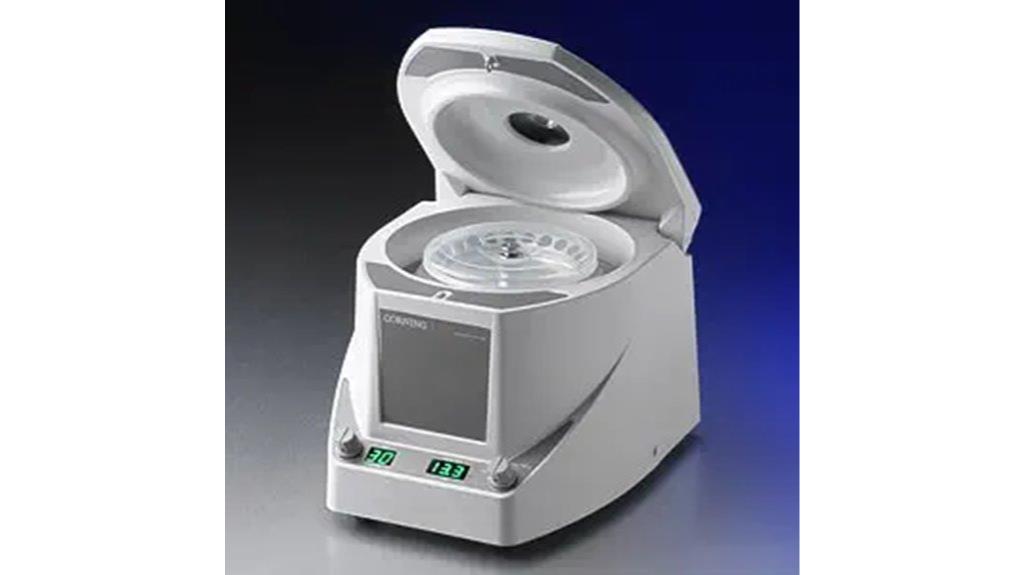
If you’re searching for a compact yet powerful microcentrifuge suited for quick, high-precision sample processing, the Corning LSE 6766-HS stands out. It reaches speeds up to 13,300 rpm or 16,300 x g, perfect for nucleic acid and protein separations. Its digital control system with two knobs allows precise adjustments of speed and run time, with clear LED displays. The brushless drive ensures smooth operation, while the air cooling system keeps noise low and samples cool during extended runs. It comes with a rotor compatible with 24 tubes, making it ideal for efficient, quiet, and reliable laboratory centrifugation.
Best For: researchers and laboratory professionals needing a compact, high-speed centrifuge for quick, precise nucleic acid and protein separations with minimal noise and sample heating.
Pros:
- High maximum speed of 13,300 rpm / 16,300 x g for efficient sample separation
- Easy-to-use digital control system with LED displays and adjustable knobs for precise settings
- Quiet operation with effective air cooling to minimize noise and maintain sample integrity during extended runs
Cons:
- Limited rotor capacity to 24 tubes, which may not suit large-volume processing needs
- Requires 230V power supply, possibly limiting use in regions with different electrical standards
- Slightly higher cost compared to basic microcentrifuges due to advanced features and high-speed performance
Mxmoonant Mini Centrifuge Machine (12000RPM)
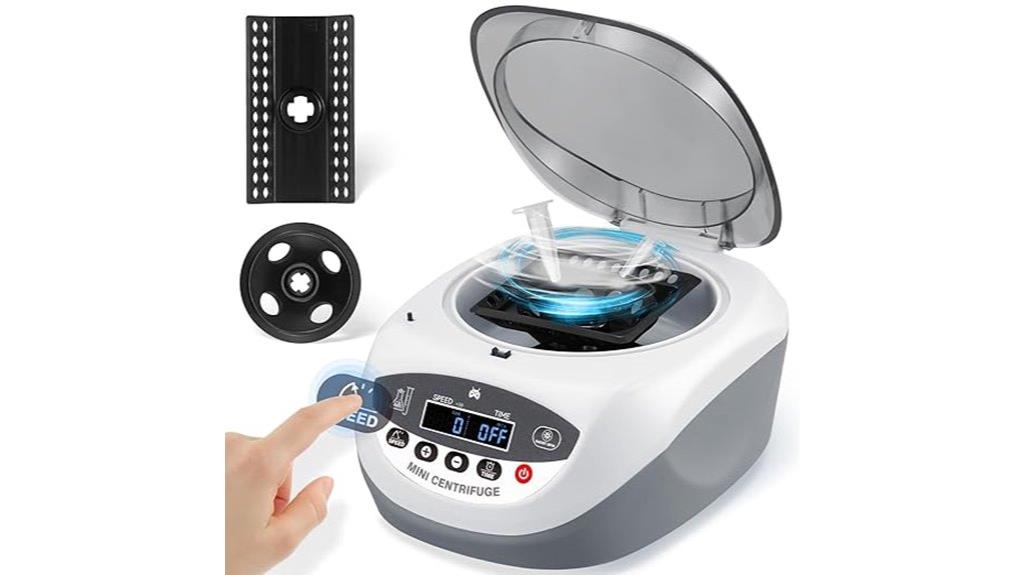
For labs seeking a compact yet powerful centrifuge, the Mxmoonant Mini Centrifuge Machine stands out with its impressive 12,000 RPM speed. It delivers high-speed sample separation essential for PCR, microfiltration, and other lab tasks. Its robust motor guarantees consistent, reliable performance, while its lightweight, space-saving design makes it easy to place on benchtops or store away. The digital keypad allows precise control of speed and time, reducing errors and streamlining workflows. With interchangeable rotors supporting various tube sizes, it offers versatility for different sample volumes. Overall, this mini centrifuge combines power, ease of use, and practicality, making it a valuable tool in any modern laboratory setting.
Best For: researchers, students, and laboratory professionals seeking a compact, high-speed centrifuge for PCR, microfiltration, and sample separation tasks.
Pros:
- Powerful 12,000 RPM motor ensures efficient and reliable sample separation.
- Compact and lightweight design conserves workspace and allows easy placement on benchtops.
- Digital keypad control provides precise, user-friendly adjustment of speed and time settings.
Cons:
- Limited capacity for large-volume samples, holding only four 5 mL tubes (total 20 mL).
- Potential electrical issues reported, possibly related to handling or packaging.
- May be less suitable for very high-volume or industrial laboratory applications.
Mxmoonant Centrifuge Machine, 15mlX6 Lab Benchtop PRP Centrifuges
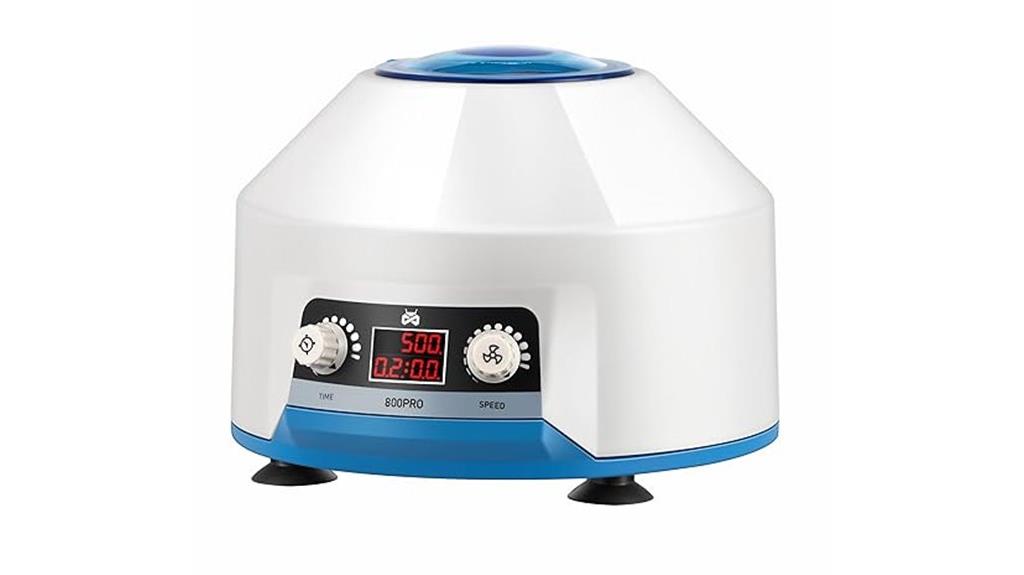
The Mxmoonant Centrifuge Machine stands out with its precise control and user-friendly features, making it ideal for laboratories focused on plasma preparation and particle separation. Its 4000RPM electric desktop design includes an LCD digital display for real-time monitoring and easy operation. Adjustable speed and time controls let you customize your centrifugation parameters, supporting 15ml tubes up to 118mm in length. Operating quietly at ≤50db with a 50W motor, it offers reliable performance and high accuracy. Whether for research or clinical use, this benchtop centrifuge ensures efficient separation with consistent results, simplifying your workflow.
Best For: laboratories and research facilities focused on plasma preparation, particle separation, and high-speed centrifugation tasks requiring precise control and reliable performance.
Pros:
- LCD digital display for real-time operation monitoring
- Adjustable speed and time controls for customized centrifugation
- Supports 15ml tubes with high precision and quiet operation
Cons:
- Limited to tubes with a maximum length of 118mm and diameter of 16mm
- Operates at a fixed voltage of 110V, which may require converters in some regions
- Noise level, while low, may still be noticeable in quiet laboratory environments
Factors to Consider When Choosing High‑Speed Ultracentrifuges
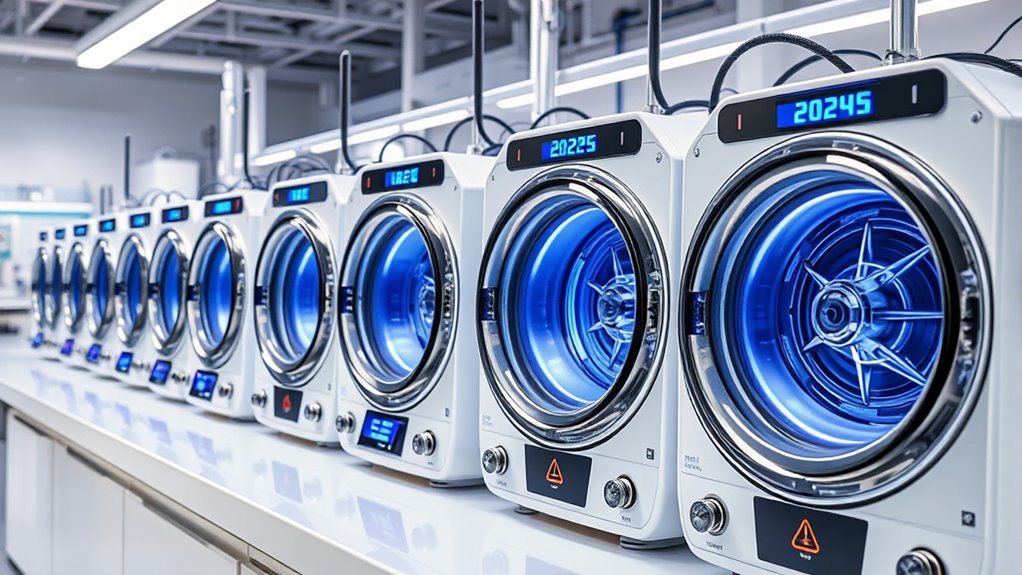
When selecting a high-speed ultracentrifuge, I consider key factors like speed and RCF range to guarantee it meets my sample requirements. Safety features and stability are essential for reliable operation, while capacity and compatibility influence how well it fits into my workflow. Additionally, ease of control, noise levels, and thermal management play critical roles in overall usability.
Speed and RCF Range
Choosing a high-speed ultracentrifuge involves considering its speed and RCF range, which directly influence its versatility and effectiveness. These devices typically operate above 20,000 rpm, enabling the separation of tiny particles and molecules. The RCF, often ranging from tens of thousands to over 100,000 x g, determines the force applied during centrifugation. Precise control over both parameters allows for tailored protocols suited to specific samples, whether for cell fractionation or protein purification. It’s essential to remember that RCF depends on rotor radius, requiring calibration for accuracy. A wide speed and RCF range ensures the ultracentrifuge can handle diverse applications, making it a valuable tool for advanced research and laboratory demands.
Safety and Stability Features
Safety and stability features are indispensable considerations because they directly impact both user protection and sample integrity. An ultracentrifuge should have automatic lid-stop and lock mechanisms to prevent accidental opening during operation, reducing risks of injury. Vibration dampening and anti-slip feet are critical for maintaining stability, minimizing vibrations that could affect delicate samples or cause accidents. Overheat protection systems help prevent thermal hazards and ensure consistent performance during long runs. Clear safety indicators and alarms are essential for alerting users to issues like imbalance or over-speed, allowing quick corrective action. Additionally, robust rotor locking and balanced loading mechanisms markedly reduce the risk of mechanical failure or rotor ejection. These features work together to create a safer, more reliable environment for both operators and samples.
Capacity and Compatibility
Selecting a high-speed ultracentrifuge requires careful attention to its capacity and compatibility features to guarantee it meets your specific laboratory needs. First, ensure the rotor capacity matches your sample volume requirements; for example, if you work with large samples, look for models supporting 15 ml tubes or larger. Compatibility is key—verify that the rotor can accommodate the types and sizes of tubes used in your lab, preventing any fit issues. Check the maximum loading capacity to avoid overfilling, which can impact safety and performance at high speeds. Additionally, consider whether the centrifuge offers versatile rotor options suitable for blood collection tubes, microcentrifuge tubes, or larger bottles. A flexible rotor system allows for handling diverse samples without frequent hardware changes, streamlining your workflow.
Control and Ease of Use
When evaluating high-speed ultracentrifuges, I look for digital control panels that let me set speeds and run times precisely, which helps minimize operator errors. User-friendly interfaces with clear displays and intuitive buttons make it easy to adjust settings and monitor progress quickly. Programmable functions and memory options save frequently used protocols, streamlining repetitive tasks and increasing efficiency. Accurate control over acceleration and deceleration rates ensures safety and consistency in results. Features like auto lid-stop, overload protection, and straightforward calibration procedures further enhance ease of use, making the centrifuge accessible to users with varying experience levels. Overall, a well-designed control system simplifies operation, reduces the likelihood of mistakes, and boosts confidence in achieving reliable, reproducible outcomes.
Noise and Thermal Management
A key consideration when choosing a high-speed ultracentrifuge is how well it manages noise and heat during operation. Ultracentrifuges with advanced cooling systems and efficient airflow help keep internal temperatures stable, preventing heat buildup that could compromise sample integrity. Low noise levels, ideally at or below 55dB, ensure a quieter lab environment, reducing operator fatigue and distractions. Proper thermal management is essential for prolonged runs, as it prevents sample degradation and maintains experimental accuracy. Vibration dampening features minimize mechanical vibrations, enhancing stability and further reducing noise. Additionally, built-in noise and temperature monitoring systems allow real-time adjustments, giving you better control over operational conditions and ensuring consistent, reliable results during high-speed centrifugation.
Frequently Asked Questions
How Do Ultracentrifuges Differ From Standard Laboratory Centrifuges?
Ultracentrifuges differ from standard centrifuges mainly in their ability to spin at much higher speeds, often exceeding 100,000 RPM. This allows them to separate smaller particles, like viruses or proteins, with greater precision. I find that ultracentrifuges are essential for detailed research, offering faster, more accurate results than standard centrifuges, which are better suited for larger, less delicate separations.
What Are the Safety Features of High-Speed Ultracentrifuges?
High-speed ultracentrifuges come with several safety features I rely on daily. They include automatic rotor lock systems, imbalance detection, and emergency shutoff options that activate if irregularities occur. Additionally, they have robust lid locks and insulated chambers to prevent accidents. These features give me peace of mind, ensuring safe operation even at extremely high speeds. Prioritizing safety helps me work confidently and avoid mishaps.
How Energy-Efficient Are Modern Ultracentrifuge Models?
Modern ultracentrifuge models are surprisingly energy-efficient, thanks to advanced motor technology and smart design features. I’ve noticed they consume less power while maintaining high performance, which not only saves energy but also reduces operational costs. Many models include energy-saving modes and automatic shut-offs, making them more environmentally friendly. Overall, I find that today’s ultracentrifuges balance power and efficiency, helping me get reliable results without wasting energy.
What Maintenance Is Required for Optimal Ultracentrifuge Performance?
To keep my ultracentrifuge performing at its best, I regularly clean the rotor and chamber to prevent buildup, check and balance the samples carefully, and perform routine calibration. I also inspect for wear and tear on belts and bearings, replace them when necessary, and guarantee the cooling system functions properly. Following the manufacturer’s maintenance schedule helps me maintain precision, safety, and prolongs the equipment’s lifespan.
How Do Ultracentrifuge Capacities Impact Experimental Throughput?
I find that ultracentrifuge capacities considerably impact my experimental throughput. Larger capacity units allow me to process more samples simultaneously, saving time and increasing efficiency. However, I also consider that bigger rotors require more maintenance and may have longer run times. Balancing capacity with operational needs helps me optimize my workflow, ensuring I get accurate results without sacrificing speed or precision.
Conclusion
So, after all this talk about speed and precision, you might think the fastest ultracentrifuge is the ultimate choice. But don’t be fooled—sometimes, rushing through samples can lead to errors you’ll regret. Remember, in the race for efficiency, quality and safety should never be sacrificed. After all, isn’t it ironic how the quickest machines demand the most careful handling? Choose wisely, and let patience be your real speed.
